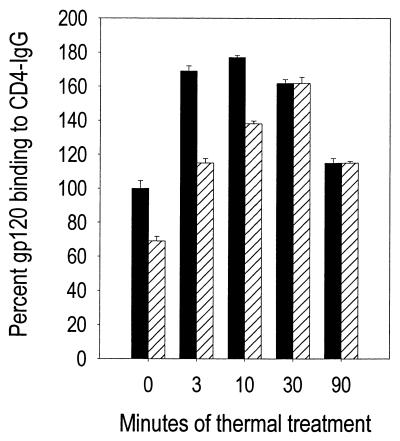FIG. 5.
Chemical treatment of HIV-1 in conjunction with thermal treatment maintains enhanced antigenicity of envelope structures. HIVSX was prepared as described for Fig. 1. A stock solution of formaldehyde was freshly diluted in PBS and added to the virus, resulting in a final concentration of 0.02%. After 1 h at 37°C, an equal volume of 0.2% BSA in PBS was added to quench residual aldehyde. The buffer was removed by diafiltration through a 100-kDa-cutoff ultrafiltration device (Millipore) by centrifugation at 10,000 rpm. The filtrate (approximately 95% of the volume) was removed by aspiration, and PBS was added to the top cell to reconstitute the sample to the original volume. After inversion, the device was centrifuged at 10,000 rpm. This process was repeated a total of four times, resulting in a 160,000-fold dilution of the low-molecular-weight molecules, including residual aldehyde. Thermal treatment of HIV-1 was performed as previously described. At the end of the incubation period, the sample was immediately cooled to 4°C. Samples from each temperature point were assessed by gp120 capture ELISA using recombinant CD4-IgG as the first antibody. Data are expressed as percent binding to CD4-IgG relative to untreated (time zero) HIVSX held at 4°C. ■, thermal treatment; ▨, formaldehyde plus thermal treatment.

